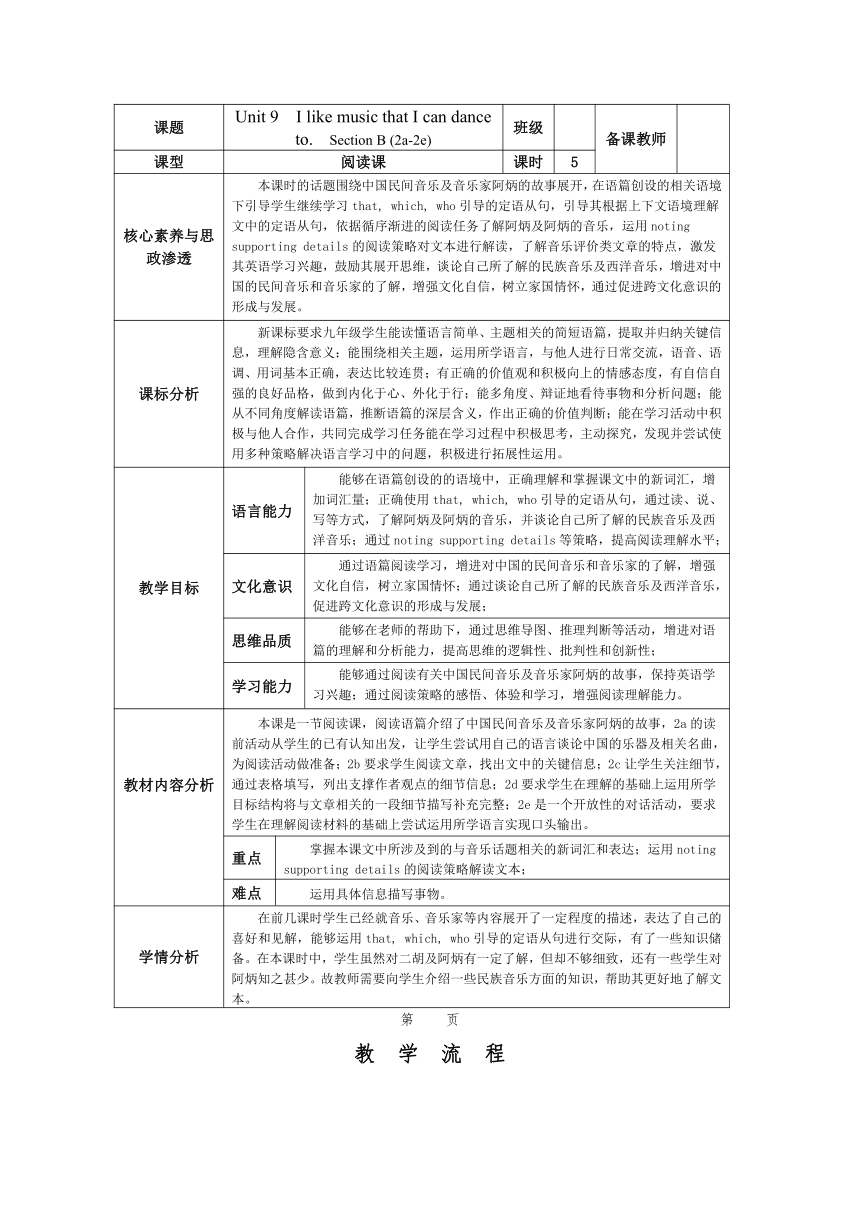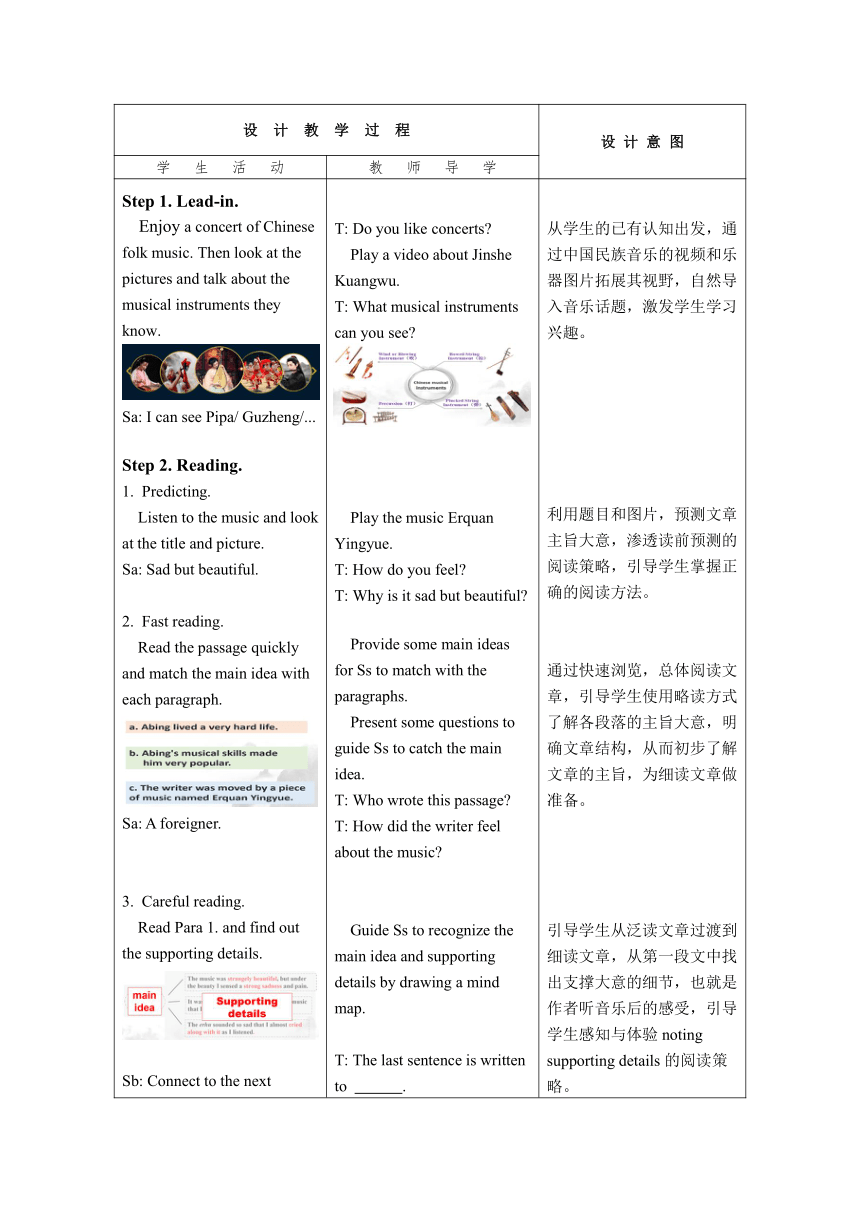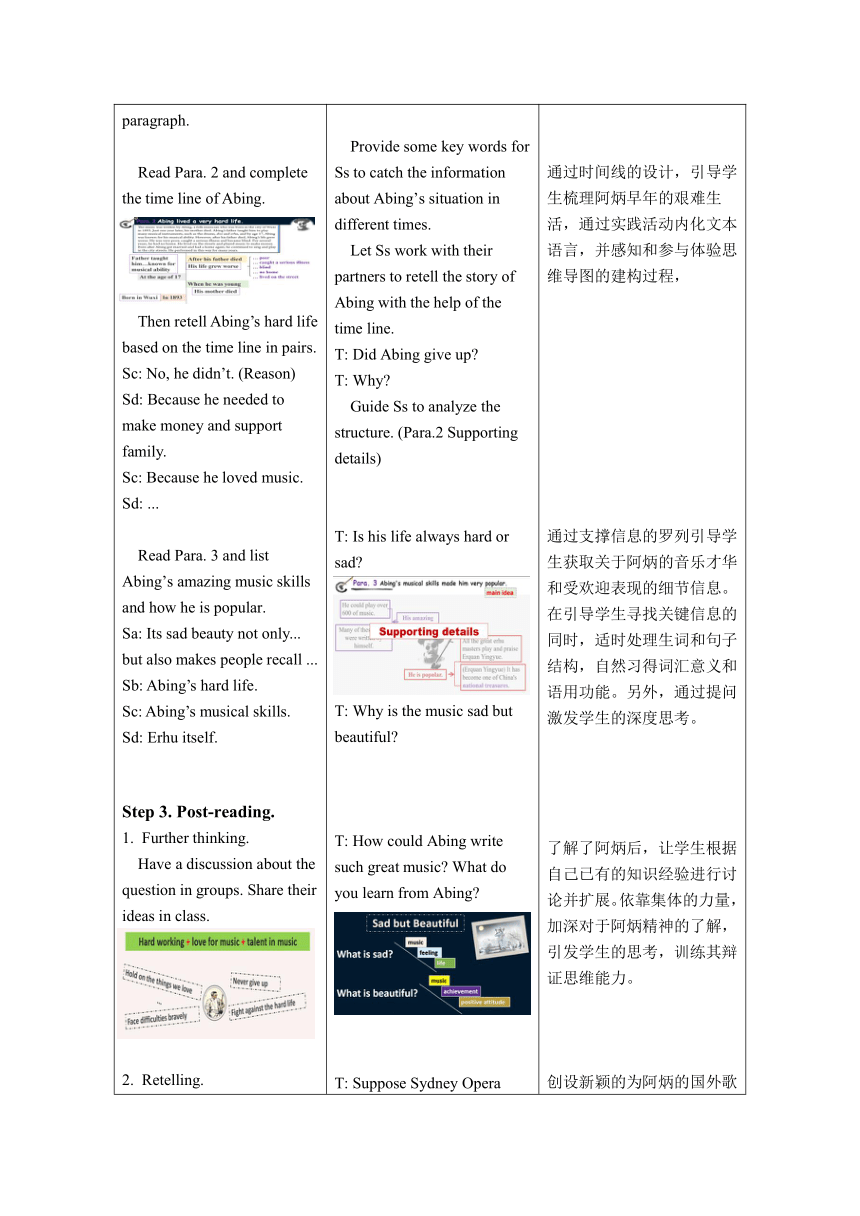【核心素养目标】Unit 9 I like music that I can dance to. Section B (2a-2e) 表格式教案
文档属性
| 名称 | 【核心素养目标】Unit 9 I like music that I can dance to. Section B (2a-2e) 表格式教案 |  | |
| 格式 | docx | ||
| 文件大小 | 717.0KB | ||
| 资源类型 | 教案 | ||
| 版本资源 | 人教新目标(Go for it)版 | ||
| 科目 | 英语 | ||
| 更新时间 | 2024-09-24 14:37:49 | ||
图片预览



文档简介
课题 Unit 9 I like music that I can dance to. Section B (2a-2e) 班级 备课教师
课型 阅读课 课时 5
核心素养与思政渗透 本课时的话题围绕中国民间音乐及音乐家阿炳的故事展开,在语篇创设的相关语境下引导学生继续学习that, which, who引导的定语从句,引导其根据上下文语境理解文中的定语从句,依据循序渐进的阅读任务了解阿炳及阿炳的音乐,运用noting supporting details的阅读策略对文本进行解读,了解音乐评价类文章的特点,激发其英语学习兴趣,鼓励其展开思维,谈论自己所了解的民族音乐及西洋音乐,增进对中国的民间音乐和音乐家的了解,增强文化自信,树立家国情怀,通过促进跨文化意识的形成与发展。
课标分析 新课标要求九年级学生能读懂语言简单、主题相关的简短语篇,提取并归纳关键信息,理解隐含意义;能围绕相关主题,运用所学语言,与他人进行日常交流,语音、语调、用词基本正确,表达比较连贯;有正确的价值观和积极向上的情感态度,有自信自强的良好品格,做到内化于心、外化于行;能多角度、辩证地看待事物和分析问题;能从不同角度解读语篇,推断语篇的深层含义,作出正确的价值判断;能在学习活动中积极与他人合作,共同完成学习任务能在学习过程中积极思考,主动探究,发现并尝试使用多种策略解决语言学习中的问题,积极进行拓展性运用。
教学目标 语言能力 能够在语篇创设的的语境中,正确理解和掌握课文中的新词汇,增加词汇量;正确使用that, which, who引导的定语从句,通过读、说、写等方式,了解阿炳及阿炳的音乐,并谈论自己所了解的民族音乐及西洋音乐;通过noting supporting details等策略,提高阅读理解水平;
文化意识 通过语篇阅读学习,增进对中国的民间音乐和音乐家的了解,增强文化自信,树立家国情怀;通过谈论自己所了解的民族音乐及西洋音乐,促进跨文化意识的形成与发展;
思维品质 能够在老师的帮助下,通过思维导图、推理判断等活动,增进对语篇的理解和分析能力,提高思维的逻辑性、批判性和创新性;
学习能力 能够通过阅读有关中国民间音乐及音乐家阿炳的故事,保持英语学习兴趣;通过阅读策略的感悟、体验和学习,增强阅读理解能力。
教材内容分析 本课是一节阅读课,阅读语篇介绍了中国民间音乐及音乐家阿炳的故事,2a的读前活动从学生的已有认知出发,让学生尝试用自己的语言谈论中国的乐器及相关名曲,为阅读活动做准备;2b要求学生阅读文章,找出文中的关键信息;2c让学生关注细节,通过表格填写,列出支撑作者观点的细节信息;2d要求学生在理解的基础上运用所学目标结构将与文章相关的一段细节描写补充完整;2e是一个开放性的对话活动,要求学生在理解阅读材料的基础上尝试运用所学语言实现口头输出。
重点 掌握本课文中所涉及到的与音乐话题相关的新词汇和表达;运用noting supporting details的阅读策略解读文本;
难点 运用具体信息描写事物。
学情分析 在前几课时学生已经就音乐、音乐家等内容展开了一定程度的描述,表达了自己的喜好和见解,能够运用that, which, who引导的定语从句进行交际,有了一些知识储备。在本课时中,学生虽然对二胡及阿炳有一定了解,但却不够细致,还有一些学生对阿炳知之甚少。故教师需要向学生介绍一些民族音乐方面的知识,帮助其更好地了解文本。
第 页
教 学 流 程
设 计 教 学 过 程 设 计 意 图
学 生 活 动 教 师 导 学
Step 1. Lead-in. Enjoy a concert of Chinese folk music. Then look at the pictures and talk about the musical instruments they know. Sa: I can see Pipa/ Guzheng/... Step 2. Reading. Predicting. Listen to the music and look at the title and picture. Sa: Sad but beautiful. Fast reading. Read the passage quickly and match the main idea with each paragraph. Sa: A foreigner. Careful reading. Read Para 1. and find out the supporting details. Sb: Connect to the next paragraph. Read Para. 2 and complete the time line of Abing. Then retell Abing’s hard life based on the time line in pairs. Sc: No, he didn’t. (Reason) Sd: Because he needed to make money and support family. Sc: Because he loved music. Sd: ... Read Para. 3 and list Abing’s amazing music skills and how he is popular. Sa: Its sad beauty not only... but also makes people recall ... Sb: Abing’s hard life. Sc: Abing’s musical skills. Sd: Erhu itself. Step 3. Post-reading. Further thinking. Have a discussion about the question in groups. Share their ideas in class. Retelling. Work in groups and try to design a ticket to Abing's concert in Sydney. Step 4. Conclusion. T: Do you like concerts Play a video about Jinshe Kuangwu. T: What musical instruments can you see Play the music Erquan Yingyue. T: How do you feel T: Why is it sad but beautiful Provide some main ideas for Ss to match with the paragraphs. Present some questions to guide Ss to catch the main idea. T: Who wrote this passage T: How did the writer feel about the music Guide Ss to recognize the main idea and supporting details by drawing a mind map. T: The last sentence is written to . Provide some key words for Ss to catch the information about Abing’s situation in different times. Let Ss work with their partners to retell the story of Abing with the help of the time line. T: Did Abing give up T: Why Guide Ss to analyze the structure. (Para.2 Supporting details) T: Is his life always hard or sad T: Why is the music sad but beautiful T: How could Abing write such great music What do you learn from Abing T: Suppose Sydney Opera House will hold concerts of Chinese folk music, could you design a ticket to Abing's concert Provide a sample and structure to help Ss. 从学生的已有认知出发,通过中国民族音乐的视频和乐器图片拓展其视野,自然导入音乐话题,激发学生学习兴趣。 利用题目和图片,预测文章主旨大意,渗透读前预测的阅读策略,引导学生掌握正确的阅读方法。 通过快速浏览,总体阅读文章,引导学生使用略读方式了解各段落的主旨大意,明确文章结构,从而初步了解文章的主旨,为细读文章做准备。 引导学生从泛读文章过渡到细读文章,从第一段文中找出支撑大意的细节,也就是作者听音乐后的感受,引导学生感知与体验noting supporting details的阅读策略。 通过时间线的设计,引导学生梳理阿炳早年的艰难生活,通过实践活动内化文本语言,并感知和参与体验思维导图的建构过程, 通过支撑信息的罗列引导学生获取关于阿炳的音乐才华和受欢迎表现的细节信息。在引导学生寻找关键信息的同时,适时处理生词和句子结构,自然习得词汇意义和语用功能。另外,通过提问激发学生的深度思考。 了解了阿炳后,让学生根据自己已有的知识经验进行讨论并扩展。依靠集体的力量,加深对于阿炳精神的了解,引发学生的思考,训练其辩证思维能力。 创设新颖的为阿炳的国外歌唱会设计门票的情境,引导学习整合文章主要信息,再次检查学生对文章细节的获取、理解和复述,巩固语言知识,帮助学生梳理文章内容,提升逻辑、创新思维,并将所学到的语言知识进行内化和创造性输出。
第 页
课 时 达 标 检 测
Ⅰ. 用方框中所给单词的适当形式填空,有两个多余项。 praise, master, reflect, sense, wound, know, piece
1.The of music sounds beautiful. 2.Steve saved Ms. Taylor from the burning house. So he by the local fire department. 3.The nurse asked me to sit on the chair. Then she helped me to clean the . 4.When I watched the movie The Captain, I a strong sadness and pain. 5.I think a foreign language is very difficult. Ⅱ.词语运用,有两个词为多余项。 energy, worry, improve, pleasure, who, fit, something, which, note, as, easy, serious
Why is music an important subject that every child should study First of all, music helps us when we are unhappy, and gives us 1. when we are happy. There are many different types of music: slow and fast, 2. and relaxing… We can choose the music 3. our moods(心情). And second, music is fun. Everyone enjoys playing the drums and using their 4. . Scientists say that music helps children with language learning. Music 5. the ear—and we know that children who have studied music can learn language more 6. and pronounce much better. Students 7. have learnt to play music are also better at math. This is not surprising, 8. music is mathematical(数学的), with 9. in order. Playing music with other people also helps children to work together. People who can play musical instruments always have 10. they can do at a party.
第 页
课 时 教 学 设 计 尾 页
板 书 设 计
Unit 9 I like music that I can dance to. Section B (2a-2e)
作 业 设 计
Level A There is a lot of beautiful Chinese folk music. Some songs are sad but some are not. Please look up the history of the music and write a short passage of one song. Use the structure of what we learned today to help you.
Level B Draw a mind-map of the passage “Sad but Beautiful”.
教 学 反 思
第 页
课型 阅读课 课时 5
核心素养与思政渗透 本课时的话题围绕中国民间音乐及音乐家阿炳的故事展开,在语篇创设的相关语境下引导学生继续学习that, which, who引导的定语从句,引导其根据上下文语境理解文中的定语从句,依据循序渐进的阅读任务了解阿炳及阿炳的音乐,运用noting supporting details的阅读策略对文本进行解读,了解音乐评价类文章的特点,激发其英语学习兴趣,鼓励其展开思维,谈论自己所了解的民族音乐及西洋音乐,增进对中国的民间音乐和音乐家的了解,增强文化自信,树立家国情怀,通过促进跨文化意识的形成与发展。
课标分析 新课标要求九年级学生能读懂语言简单、主题相关的简短语篇,提取并归纳关键信息,理解隐含意义;能围绕相关主题,运用所学语言,与他人进行日常交流,语音、语调、用词基本正确,表达比较连贯;有正确的价值观和积极向上的情感态度,有自信自强的良好品格,做到内化于心、外化于行;能多角度、辩证地看待事物和分析问题;能从不同角度解读语篇,推断语篇的深层含义,作出正确的价值判断;能在学习活动中积极与他人合作,共同完成学习任务能在学习过程中积极思考,主动探究,发现并尝试使用多种策略解决语言学习中的问题,积极进行拓展性运用。
教学目标 语言能力 能够在语篇创设的的语境中,正确理解和掌握课文中的新词汇,增加词汇量;正确使用that, which, who引导的定语从句,通过读、说、写等方式,了解阿炳及阿炳的音乐,并谈论自己所了解的民族音乐及西洋音乐;通过noting supporting details等策略,提高阅读理解水平;
文化意识 通过语篇阅读学习,增进对中国的民间音乐和音乐家的了解,增强文化自信,树立家国情怀;通过谈论自己所了解的民族音乐及西洋音乐,促进跨文化意识的形成与发展;
思维品质 能够在老师的帮助下,通过思维导图、推理判断等活动,增进对语篇的理解和分析能力,提高思维的逻辑性、批判性和创新性;
学习能力 能够通过阅读有关中国民间音乐及音乐家阿炳的故事,保持英语学习兴趣;通过阅读策略的感悟、体验和学习,增强阅读理解能力。
教材内容分析 本课是一节阅读课,阅读语篇介绍了中国民间音乐及音乐家阿炳的故事,2a的读前活动从学生的已有认知出发,让学生尝试用自己的语言谈论中国的乐器及相关名曲,为阅读活动做准备;2b要求学生阅读文章,找出文中的关键信息;2c让学生关注细节,通过表格填写,列出支撑作者观点的细节信息;2d要求学生在理解的基础上运用所学目标结构将与文章相关的一段细节描写补充完整;2e是一个开放性的对话活动,要求学生在理解阅读材料的基础上尝试运用所学语言实现口头输出。
重点 掌握本课文中所涉及到的与音乐话题相关的新词汇和表达;运用noting supporting details的阅读策略解读文本;
难点 运用具体信息描写事物。
学情分析 在前几课时学生已经就音乐、音乐家等内容展开了一定程度的描述,表达了自己的喜好和见解,能够运用that, which, who引导的定语从句进行交际,有了一些知识储备。在本课时中,学生虽然对二胡及阿炳有一定了解,但却不够细致,还有一些学生对阿炳知之甚少。故教师需要向学生介绍一些民族音乐方面的知识,帮助其更好地了解文本。
第 页
教 学 流 程
设 计 教 学 过 程 设 计 意 图
学 生 活 动 教 师 导 学
Step 1. Lead-in. Enjoy a concert of Chinese folk music. Then look at the pictures and talk about the musical instruments they know. Sa: I can see Pipa/ Guzheng/... Step 2. Reading. Predicting. Listen to the music and look at the title and picture. Sa: Sad but beautiful. Fast reading. Read the passage quickly and match the main idea with each paragraph. Sa: A foreigner. Careful reading. Read Para 1. and find out the supporting details. Sb: Connect to the next paragraph. Read Para. 2 and complete the time line of Abing. Then retell Abing’s hard life based on the time line in pairs. Sc: No, he didn’t. (Reason) Sd: Because he needed to make money and support family. Sc: Because he loved music. Sd: ... Read Para. 3 and list Abing’s amazing music skills and how he is popular. Sa: Its sad beauty not only... but also makes people recall ... Sb: Abing’s hard life. Sc: Abing’s musical skills. Sd: Erhu itself. Step 3. Post-reading. Further thinking. Have a discussion about the question in groups. Share their ideas in class. Retelling. Work in groups and try to design a ticket to Abing's concert in Sydney. Step 4. Conclusion. T: Do you like concerts Play a video about Jinshe Kuangwu. T: What musical instruments can you see Play the music Erquan Yingyue. T: How do you feel T: Why is it sad but beautiful Provide some main ideas for Ss to match with the paragraphs. Present some questions to guide Ss to catch the main idea. T: Who wrote this passage T: How did the writer feel about the music Guide Ss to recognize the main idea and supporting details by drawing a mind map. T: The last sentence is written to . Provide some key words for Ss to catch the information about Abing’s situation in different times. Let Ss work with their partners to retell the story of Abing with the help of the time line. T: Did Abing give up T: Why Guide Ss to analyze the structure. (Para.2 Supporting details) T: Is his life always hard or sad T: Why is the music sad but beautiful T: How could Abing write such great music What do you learn from Abing T: Suppose Sydney Opera House will hold concerts of Chinese folk music, could you design a ticket to Abing's concert Provide a sample and structure to help Ss. 从学生的已有认知出发,通过中国民族音乐的视频和乐器图片拓展其视野,自然导入音乐话题,激发学生学习兴趣。 利用题目和图片,预测文章主旨大意,渗透读前预测的阅读策略,引导学生掌握正确的阅读方法。 通过快速浏览,总体阅读文章,引导学生使用略读方式了解各段落的主旨大意,明确文章结构,从而初步了解文章的主旨,为细读文章做准备。 引导学生从泛读文章过渡到细读文章,从第一段文中找出支撑大意的细节,也就是作者听音乐后的感受,引导学生感知与体验noting supporting details的阅读策略。 通过时间线的设计,引导学生梳理阿炳早年的艰难生活,通过实践活动内化文本语言,并感知和参与体验思维导图的建构过程, 通过支撑信息的罗列引导学生获取关于阿炳的音乐才华和受欢迎表现的细节信息。在引导学生寻找关键信息的同时,适时处理生词和句子结构,自然习得词汇意义和语用功能。另外,通过提问激发学生的深度思考。 了解了阿炳后,让学生根据自己已有的知识经验进行讨论并扩展。依靠集体的力量,加深对于阿炳精神的了解,引发学生的思考,训练其辩证思维能力。 创设新颖的为阿炳的国外歌唱会设计门票的情境,引导学习整合文章主要信息,再次检查学生对文章细节的获取、理解和复述,巩固语言知识,帮助学生梳理文章内容,提升逻辑、创新思维,并将所学到的语言知识进行内化和创造性输出。
第 页
课 时 达 标 检 测
Ⅰ. 用方框中所给单词的适当形式填空,有两个多余项。 praise, master, reflect, sense, wound, know, piece
1.The of music sounds beautiful. 2.Steve saved Ms. Taylor from the burning house. So he by the local fire department. 3.The nurse asked me to sit on the chair. Then she helped me to clean the . 4.When I watched the movie The Captain, I a strong sadness and pain. 5.I think a foreign language is very difficult. Ⅱ.词语运用,有两个词为多余项。 energy, worry, improve, pleasure, who, fit, something, which, note, as, easy, serious
Why is music an important subject that every child should study First of all, music helps us when we are unhappy, and gives us 1. when we are happy. There are many different types of music: slow and fast, 2. and relaxing… We can choose the music 3. our moods(心情). And second, music is fun. Everyone enjoys playing the drums and using their 4. . Scientists say that music helps children with language learning. Music 5. the ear—and we know that children who have studied music can learn language more 6. and pronounce much better. Students 7. have learnt to play music are also better at math. This is not surprising, 8. music is mathematical(数学的), with 9. in order. Playing music with other people also helps children to work together. People who can play musical instruments always have 10. they can do at a party.
第 页
课 时 教 学 设 计 尾 页
板 书 设 计
Unit 9 I like music that I can dance to. Section B (2a-2e)
作 业 设 计
Level A There is a lot of beautiful Chinese folk music. Some songs are sad but some are not. Please look up the history of the music and write a short passage of one song. Use the structure of what we learned today to help you.
Level B Draw a mind-map of the passage “Sad but Beautiful”.
教 学 反 思
第 页
同课章节目录
- Unit 1 How can we become good learners.
- Section A
- Section B
- Unit 2 I think that mooncakes are delicious!
- Section A
- Section B
- Unit 3 Could you please tell me where the restroom
- Section A
- Section B
- Unit 4 I used to be afraid of the dark.
- Section A
- Section B
- Unit 5 What are the shirts made of?
- Section A
- Section B
- Review of Units 1-5
- Unit 6 When was it invented?
- Section A
- Section B
- Unit 7 Teenagers should be allowed to choose their
- Section A
- Section B
- Unit 8 It must belong to Carla.
- Section A
- Section B
- Unit 9 I like music that I can dance to.
- Section A
- Section B
- Unit 10 You're supposed to shake hands.
- Section A
- Section B
- Review of Units 6-10
- Unit 11 Sad movies make me cry.
- Section A
- Section B
- Unit 12 Life is full of the unexpected
- Section A
- Section B
- Unit 13 We're trying to save the earth!
- Section A
- Section B
- Unit 14 I remember meeting all of you in Grade 7.
- Section A
- Section B
- Review of Units 11-14
